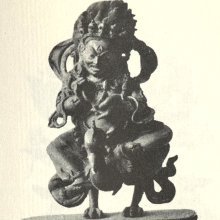Ankushadhara, Aṅkuśadhara, Aṃkuśadhara, Ankusha-dhara, Aṅkuśadharā, Aṃkuśadharā: 5 definitions
Introduction:
Ankushadhara means something in Hinduism, Sanskrit. If you want to know the exact meaning, history, etymology or English translation of this term then check out the descriptions on this page. Add your comment or reference to a book if you want to contribute to this summary article.
The Sanskrit terms Aṅkuśadhara and Aṃkuśadhara and Aṅkuśadharā and Aṃkuśadharā can be transliterated into English as Ankusadhara or Ankushadhara or Amkusadhara or Amkushadhara, using the IAST transliteration scheme (?).
Images (photo gallery)
In Hinduism
Shaktism (Shakta philosophy)
Source: Google Books: ManthanabhairavatantramAṅkuśadharā (अङ्कुशधरा) refers to “she who holds a goad”, according to the Manthānabhairavatantra, a vast sprawling work that belongs to a corpus of Tantric texts concerned with the worship of the goddess Kubjikā.—Accordingly, “(Jvālāmaṅgalyā), the goddess born of Jāla is very dignified and powerful. She has five faces, four arms, and sits on a white lion. She holds sword, club, fetter, and goad [i.e., aṅkuśadharā—pāśāṅkuśadharā] and is adorned with jewels. She wears clothes of various colours, is fierce and, when worshipped, bestows boons”.
Source: Brill: Śaivism and the Tantric Traditions (shaktism)Aṅkuśadharā (अङ्कुशधरा) refers to “she who carries a goad” and is used to describe the deities of the ten gestures (mudrā-daśaka-devatā), according to the King Vatsarāja’s Pūjāstuti called the Kāmasiddhistuti (also Vāmakeśvarīstuti), guiding one through the worship of the Goddess Nityā.—Accordingly, “[...] May the deities of the ten gestures, who [have forms that] are in accordance with the powers of their respective gestures, are mild, and carry a snare and goad (aṅkuśadharā), endow me with the object of my desire. May the sixteen goddesses of attraction, [representing] the perennial constitutive digits of Kalānidhi [i.e. the Moon], draw towards me the object of my desire. [...]”.

Shakta (शाक्त, śākta) or Shaktism (śāktism) represents a tradition of Hinduism where the Goddess (Devi) is revered and worshipped. Shakta literature includes a range of scriptures, including various Agamas and Tantras, although its roots may be traced back to the Vedas.
Shaivism (Shaiva philosophy)
Source: Google Books: Manthanabhairavatantram (shaivism)Aṅkuśadhara (अङ्कुशधर) refers to “one who holds a goad” and represents one of the attributes of Svacchanda, according to the Śrīmatottara-tantra, an expansion of the Kubjikāmatatantra: the earliest popular and most authoritative Tantra of the Kubjikā cult. Accordingly, “O goddess, Svacchanda is in the middle, within the abode of the triangle. Very powerful, he has five faces with three times five flaming eyes. [...] O fair lady, my attributes—trident, dagger, sword, the king of the snakes, and rosary—adorn the right (arms). O beloved, a skull, double-headed drum, javelin, noose and goad [i.e., aṅkuśadhara]—(these) are my divine, brilliant and very auspicious weapons that (are held) in the left (hands). The king of snakes (hangs) on the shoulder and a garland of skulls hangs (from the neck). There is a necklace of scorpions around the throat and the ears are adorned with snakes. [...]”.
Source: SOAS University of London: Protective Rites in the Netra TantraAṅkuśadhara (अङ्कुशधर) refers to “one holding a noose” and is used to describe Bhairava, according to the Netratantra of Kṣemarāja: a Śaiva text from the 9th century in which Śiva (Bhairava) teaches Pārvatī topics such as metaphysics, cosmology, and soteriology.—Accordingly, [verse 10.1-7ab, while describing the appearance and worship of Bhairava]—“[...] He] bears a sword and shield, holds a hook and noose (aṅkuśadhara—pāśāṅkuśadharaṃ). [His] hand[s and posed] in the wish fulfilling and protection [mudrās. He] holds the thunderbolt of a great hero. [He also] holds an axe and a hatchet. Having worshipped Bhairava, [the Mantrin] remembers being joined in union [with] him, [in the same way as] dissolution in fire”.

Shaiva (शैव, śaiva) or Shaivism (śaivism) represents a tradition of Hinduism worshiping Shiva as the supreme being. Closely related to Shaktism, Shaiva literature includes a range of scriptures, including Tantras, while the root of this tradition may be traced back to the ancient Vedas.
Languages of India and abroad
Kannada-English dictionary
Source: Alar: Kannada-English corpusAṃkuśadhara (ಅಂಕುಶಧರ):—[noun] one who holds a goad, chiefly Ganēśa, the God of knowledge.
Kannada is a Dravidian language (as opposed to the Indo-European language family) mainly spoken in the southwestern region of India.
See also (Relevant definitions)
Partial matches: Ankusha, Dhara.
Ends with: Pashankushadhara.
Relevant text
No search results for Ankushadhara, Aṅkuśadhara, Aṃkuśadhara, Ankusha-dhara, Aṅkuśadharā, Aṃkuśadharā, Amkusadhara, Ankusadhara, Amkushadhara, Amkusha-dhara, Aṃkuśa-dhara, Aṃkuśa-dharā, Aṅkuśa-dharā, Aṅkuśa-dhara, Amkusa-dhara, Ankusa-dhara; (plurals include: Ankushadharas, Aṅkuśadharas, Aṃkuśadharas, dharas, Aṅkuśadharās, Aṃkuśadharās, Amkusadharas, Ankusadharas, Amkushadharas, dharās) in any book or story.
